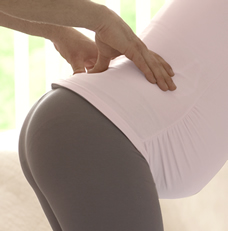
-By Helen Johnson –
Research tells us that women can maximise the chances for a physiological birth (meaning a birth without drugs or medical interventions) if they stay at home as long as possible during the labour. Women feel more relaxed at home and this means more effective coping skills. Labour may be tough, but it’s easier at home in what is perceived as a safe, relaxing and supportive environment.
Coping with labour needs both physical and mental effort. This page will help outline a few suggestions. It should be noted that, just as we all have different temperaments and personalities, so too different women cope in different ways. It is useful to have multiple tools available to use as needed. Some techniques for labour management need to be learned and practiced through pregnancy (e.g. yoga, self-hypnosis, some relaxation techniques), while others can be initiated when needed.
Support Person
Women need a supportive birth partner. If labour lasts over 24 hours you might need several support people taking shifts. A supportive partner needs to know and support your wishes and needs, and keep the mood positive and hopeful.
Frequent Position Changes
Most women instinctively can’t bear to stay in one position for too long. Don’t be scared to try something different for fear of pain – the truth is that it will hurt more if you don’t move. Active and upright positions are usually suggested to maintain contractions in the very early stages, when contractions can be irregular (e.g. walking, dancing, swaying, yoga.). Many woman get backache during labour for which forward-leaning positions can be useful. With long labours periods of rest are important and can be facilitated in upright or forward-leaning positions by utilising pillows, bean bags or exercise balls.
Shower or Bath
Water immersion has been shown to be effective in coping with the pain of contractions, possibly from its relaxing properties. Water from a hand-held nozzle can be directed onto the back or lower abdomen if desired.
Hydration and Energy
Labour is a high energy activity and maintaining good fluid intake is really important. If you’re a little nauseated, take frequent sips or suck ice blocks. The body can’t work properly if you get dehydrated. You need to occasionally take small, nutritious snacks to maintain energy (e.g. fruit, nuts, muesli bars, crackers, etc.)
Heat Packs
Heat applications onto the back or lower abdomen can be soothing. Wheat bags or Hot Water Bottles are great, but be careful not to overdo the heat and cause burns.
Massage or Counter-pressure
Massage can be relaxing and can help a woman get through contractions. Massage may be over the back, face, hands, feet or anywhere it is found to be helpful to the individual woman. Assistance with backache can sometimes be achieved with counter-pressure (a constant firm pressure over the area of most concern on the lower back) during contractions.
Distraction
Concentrating on anything other than the pain can be helpful, e.g. doing housework, counting through contractions, using stress balls, visualisation of a calming place. This takes some mental focus.
Yoga
The latest research shows that yoga can improve birth outcomes. Yoga itself assists relaxation, flexibility and core strength. Some yoga positions open the pelvis to facilitate the passage of the baby through the birth canal. Yoga needs to be practised through pregnancy for best results.
Phone the Midwife
In many cases fear will bring the woman to the hospital too early. Keep the midwife at your chosen birth facility informed of what is happening at home. The midwife may be able to reassure and give useful suggestions to keep you home longer. If you do come into hospital before labour is really established, don’t be afraid to go home again.
Relaxation
Other ways to assist relaxation is with soft lighting, familiar music, scented candles or aromatherapy and a comfortable environment. These need to be individualised to the likes of the particular woman. Some women prefer the family around, while others need quiet and stillness.
Support Person – Frequent Position Changes Shower or Bath – Hydration and Energy Heat Packs – Massage or Counter-pressure Distraction – Yoga – Phone the Midwife Relaxation
– References –
Sundin, J. (2007). Birth Skills with Sarah Murdoch. Australia: Allen & Unwin Book Publishers.
Murkoff H, Eisenberg A & Hathaway S. (2002). What to Expect When You’re Expecting. New York: Workman Publishing Company, Inc.
Winder, K. (2003). BellyBelly [unknown]. Retrieved from http://bellybelly.com.au
Lauzon L, Hodnett ED. Labour Assessment Programs to Delay Admission to Labour Wards. Cochrane Database or Systemic Reviews 2001, Issue 3. Art. No.: CD000936.DOI:10.1002/14651858. CD000936.
Smith CA, Collins CT, Cyna AM, and Crowther CA. Complementary & Alternative Therapies for Pain Management In Labour (Review). Cochrane Database or Systematic Reviews 2006, Issue 4. Art. No.: CD003521. DOI:10.1002/14651858. CD003521. Pub2.
Simkin P, BoldingA. (2004) Update on Non-pharmacological Approaches to Relieve Labour Pain & Prevent Suffering. Journal of Midwifery & Women’s Health. 49(6), pages 489-504.









You must be logged in to post a comment.